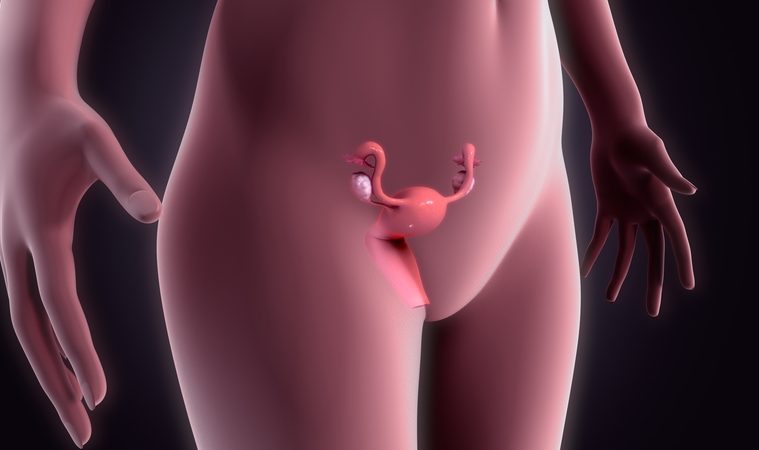
The prevalence of toxic chemicals in our daily lives is no longer in question. From the way our food is produced and manufactured to the beauty and cleaning products we use each day, it seems we have to be wary of everything. So it’s no wonder that by the time evening rolls around and we’re lying safe and secure in bed with our significant other, chemicals are the last things on our mind.
The Vagina
Recent studies have shown that the vagina is highly absorbent. One study found that vaginal application of estradiol, a synthetic estrogen, resulted in blood serum levels 10 times higher than those following oral dosing. Because the vagina is a mucous membrane — as are some of the external parts of the vulva, including the clitoris, clitoral hood, labia minora, and urethra — it can both secrete and absorb fluids at a higher rate than skin,.
“Most of the vagina is covered with multiple layers of dead and dying cells that do a lot to protect it against infection, but [this] is nowhere near the thick leathery surface of our skin,” says Richard Cone, a Johns Hopkins biophysics professor. “The vaginal epithelium … is highly water permeable in a way our skin is not.”
This physical reality makes it essential for women to be mindful of what they are putting in and on their vaginas, because it really can affect their overall health.
The problem with lube…
Charlene S. Dezzutti, a professor in the Department of Obstetrics, Gynecology, and Reproductive Sciences at the University of Pittsburgh, found that hyperosmolar lubricants and spermicidal gels killed microbes commonly found in the vagina. For example, K-Y Jelly killed all three species of Lactobacillus it was applied to. “The bacterial kill off is likely caused by the ingredient chlorhexidine, an antibacterial agent,” says Dezzutti. She also adds that personal lubricants can disrupt natural flora in the vagina, potentially leading to infections such as bacterial vaginosis.
However, since these studies are done in a lab, it’s difficult to conclude how harmful these lubricants are in the real world, “This is just a model in a test tube, and it’s hard to equate that with real-life activity,” says Dezzutti.
But studies are continually being done to ensure our safety in the bedroom. Richard A. Cone, a biophysicist at Johns Hopkins University, observed cell toxicity from hyperosmolar lubricants in his mouse model with the same glycerol monolaurate/K-Y formulation. His team saw a 10-fold increase in susceptibility to herpes with the gel.
Dezzutti explains that adding hyperosmolar lubricants — those products containing concentrations of components higher than the body’s cells — to the vagina or rectum causes the cells there to shrivel up and come off, which risks weakening the body’s defenses in these areas.
In 2007, Craig W. Hendrix, a clinical pharmacologist at Johns Hopkins, led a research team to demonstrate that ID Glide, a hyperosmolar lubricant similar to Astroglide and K-Y Jelly, can cause significant damage to the rectal tissue of human study participants. The scientists observed major shedding of cells from tissue samples biopsied 60 to 90 minutes after lubricant application.
The Relation With STIs & Other STDs
Other experiments have shown that personal lubricants can damage cells lining both the vagina and rectum, potentially making the body more vulnerable to sexually transmitted infections (STIs). In one epidemiological investigation, participants who consistently used personal lubricants for rectal intercourse had a higher prevalence of STIs, such as chlamydia, than inconsistent users.
The Food & Drug Administration normally doesn’t test personal lubricants in humans. The FDA classifies lubricants as ‘medical devices,’ which means they are only tested on animals such as rabbits and guinea pigs. When it comes to rectal use? The FDA views it as “off-label” application, so basically — use at your own risk.
Despite the growing pile of evidence indicting the safety of lube, Jim Pickett, chair of the International Rectal Microbicide Advocates (IRMA) group, a global network pushing for safe and effective STI-preventing products, says, “We have signals that are concerning, but we don’t know what they mean yet. Just because a lubricant causes cell damage in the lab, we don’t know whether that has anything to do with disease transmission in humans in the real world.”
Nonoxynol-9 & HIV
Microbicide developers were testing whether or not Nonoxynol-9 could block HIV transmission because it can punch holes in the cell membranes of sperm. Nonoxynol-9 is a detergent found in many household cleaners and cosmetics that manufacturers had been incorporating into spermicidal lubricants for years.
According to a report by the World Health Organization, “spermicides containing nonoxynol-9 do not protect against HIV infection and may even increase the risk of HIV infection in women using these products frequently”
In a 2002 Phase II/III clinical trial conducted on sex workers living in countries such as South Africa and Thailand who used the detergent three or four times per day, doctors found that the detergent actually increased the risk of HIV infection.
Because Nonoxynol-9 is so good at punching holes in cell membranes, it not only bores into sperm but also into the cells lining the vagina and rectum. “The mucosal lining of the vagina is a good barrier to infection all by itself,” says Cone, “but if that barrier gets compromised, all bets are off.”

Inspiration and all our best content, straight to your inbox.
Osmality & Herpes
Osmolality is a parameter describing the overall concentration of molecular ingredients in a product. In 2010, Cone and his team at Johns Hopkins published work showing that the damaging effects of over-the-counter lubricants depend on a factor called osmolality. What they discovered after examining mouse vaginal cells is that, when mice were exposed to high-osmolality lubricants followed by herpes simplex virus, the rodents were more susceptible to infection.
Even more shocking, the common lubricant K-Y Warming Jelly, which has an osmolality more than 30 times the body’s own fluid, increased herpes transmission 9 times more than compared with rodents not administered lubricant.
Safer Alternatives
Dr. Maggie Ney, co-director of the Women’s Clinic at the Akasha Center in Santa Monica, in a recent interview on Goop, recommends these alternatives:
- organic coconut oil
- olive oil
- aloe vera gel
- almond oil
There are plenty of brands on the market today that are conscious of the health risks conventional lubricants put on the body. Love Lotion, Sliquid, and YES are a few that come to mind which are organic.
It’s important to be vigilant with your health and consider the risks of all aspects of your life, especially when it comes to the bedroom. Sex is meant to be fun and safe, so it’s worth going the extra mile to ensure you’re doing things right.
Sources
http://ehp.niehs.nih.gov/122-a70/
http://www.honeycolony.com/article/when-sex-goes-toxic/
http://www.who.int/mediacentre/news/notes/release55/en/
http://cen.acs.org/articles/90/i50/Studies-Raise-Questions-Safety-Personal.html2012
Having Trouble Losing Excess Weight?
Having trouble losing excess weight? This could be one of the biggest reasons why.
We know so much about food now yet much of the population is overweight and unhealthy because of the quality of our food and our perception about food.
Luckily there’s a quiz that you can take to find out where you stand on food addiction. You can take it here.
After you will get results and specific information based on your score. Try the quiz!
Source Article from http://feedproxy.google.com/~r/Collective-evolution/~3/elpk_2YQKqA/
 RSS Feed
RSS Feed















 September 19th, 2017
September 19th, 2017  Awake Goy
Awake Goy 
 Posted in
Posted in  Tags:
Tags: 













